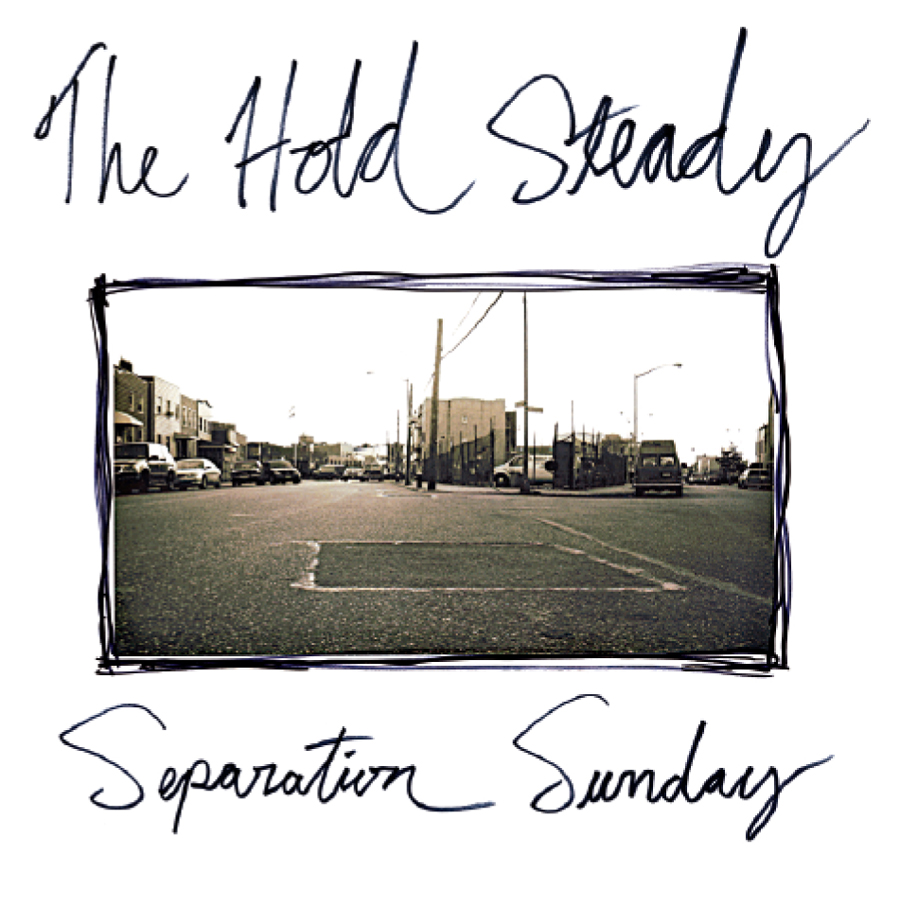“You discover something new on every listen” is a cliché that’s trotted out in music reviews every so often, usually meaning that the album is worth listening to a second or third time. Separation Sunday by The Hold Steady is a release which returns the phrase to its original meaning, still providing surprises to listeners nearly a decade after its release. Centring on the life of Hallelujah (the kids just call her Holly), Separation Sunday is a novelistic web of characters and situations littered with musical, Biblical and self-referential references sung-spoke in sing-speak, all set to a backdrop of classic rock. It’s one of my favourite albums of all time and elevates Finn to very near top of my list of living lyricists.
Out on Frenchkiss Records in 2005, this is an album infused with feel-good rock swagger, a trademark of The Hold Steady who are often tagged as a carefree band concerned only with beer and good times. For me (and many others, I’m not speaking of a revelation here), this misses the point entirely. It seems the kind of view held by people who dream of road trips after reading Kerouac. There is a glory in Finn’s work, but it is a glory intrinsically linked to sadness, a Christian glory consisting of everything from sweet nostalgia to cell-splitting, body-selling depression. The characters are going full-throttle because they are afraid of what will happen should they stop, something that brings to mind David Foster Wallace’s ideas on addiction vs. an existential void: “Drugs, movies where stuff blows up, loud parties – all these chase away loneliness by making me forget my name’s Dave.”
‘Hornets! Hornets!’ introduces us to Holly, the Bones Brigade-watching, Kate Bush-miming, Nabokov-referencing woman who goes with whoever’s going to get her the highest. It’s never quite clear exactly where she is or what is happening, a vagueness which continues onto the next track and indeed throughout the whole album. ‘Cattle & the Creeping Things’, packed with Biblical references, has always made me think of AA/NA (especially as Holly mentions going through the program), the collection of dysfunctional characters and hijinks similar to those of Infinite Jest’s Ennet House. Whether Finn intended to portray this scene is unclear (Separation Sunday is that sort of album). ‘Little Hoodrat Friend’ goes on to describe how pain and joy are linked, as in addiction, something symbolised perfectly by talk of tattoos (she’s got blue black ink and it’s scratched into her lower back. It said: Damn right he’ll rise again”). ‘Banging Camp’ tells of her descent into the nitrous-fuelled tent community pitched on the banks of the Mississippi and her refusal to slow down despite the risks:
“Holly wore a cross to ward them off.
She said if they think you’re a Christian then they won’t bring in the dogs.
And if they think you’re a catholic then they’ll wanna meet your boss.
Holly wore a cross to ward them off”
‘Charlemagne In Sweatpants’ introduces the pimp Charlemagne, a figure with whom Holly becomes entangled (“and it’s not like she’s enslaved. It’s more like she’s enthralled”) and it seems likely that Holly is accelerating, increasing elevation to avoid the comedown (“first it makes her feel tall then it makes her feel small and it’s all a sweet fleeting feeling”).
But the second half of the album sees a transformation in Holly. During ‘Stevie Nix’ the first rays of light poke through (“I was half dead. Then I got born again. I got lost in all the lights but it was ok in the end”) and ‘Multitude of Casualties’ sees the beginning of redemption (“she was feeling out the 5:30 folk mass… the night that she got born again”). ‘Don’t Let Me Explode’ is Holly’s plea for rescue (with her calling on Saint Barbara, the patron saint of a number of occupations linked to sudden death) and ‘Chicago Seemed Tired Last Night’, while not mentioning any characters by name, comes across as an advert for The Scene that Holly is leaving behind:
“We mix our own mythologies. We push them out through PA systems.
We dictate our doxologies and try to get sleeping kids to sit up and listen.
I’m not saying we could save you.
But we could put you in a place where you could save yourself.
If you don’t get born again at least you’ll get high as hell”
But Holly is out the other side. Holly saves herself. ‘Crucifixion Cruise’ sees her wake in a confession booth, sick and tired but feeling brave enough to change or at least attempt it:
“She said Lord what do you recommend?
To a real sweet girl who’s made some not sweet friends.
Lord what would you prescribe?
To a real soft girl who’s having real hard times”
The final track, a contender for my favourite, ‘How a Resurrection Really Feels’, tells of Holly crashing from the confession booth into Easter Mass. She stands among the pews in her dishevelled state and says “Father, can I tell your congregation how a resurrection really feels?” The track is a culmination of all that Separation Sunday stands for, regret and joy swirl around the church as Hallelujah confesses her adventures and troubles and finally earns her full name.
There is a section of Don DeLillo’s Underworld (an extract later released as the title story in his collection The Angel Esmeralda) that captures this atmosphere perfectly. Two nuns travel to a run-down area of the Bronx where a crew of graffiti artists paint an angel for every child that dies. The two Sisters are disillusioned by the violence and sadness they see but at the end of the story witness the inexplicable appearance of an image upon a billboard in a busy street. An image of a murdered girl, Esmeralda:
“Her presence was a verifying force, a figure from a universal church… Everything felt near at hand, breaking upon her, sadness and loss and glory and an old mother’s bleak pity and a force at some deep level of lament that made her feel inseparable from the shakers and mourners, the awestruck who stood in tidal traffic.”
Holly is away from home for a long period, a victim of her generation, mourned by her loved ones whether she is dead or otherwise (“they wrote her name in Magic Marks, on stop signs and subway cars, they got a mural up on East 13th that said Hallelujah rest in peace”). In her absence she’s a saint, in her return an angel, her redemption is full of the sadness, pity and glory. But the redemption is not hers alone. It is fundamentally personal yet communal, shared by all. What has come before happened to everyone and no-one, means everything and nothing. To return to DeLillo: “she was nameless for a moment… a disembodied fact in liquid form, pouring into the crowd.” What has happened has happened but, for that moment at least, Holly is not alone.
This post has rambled on too long already and I’ve barely mentioned the array of references scattered across the album from Nelson Algren to Rod Stewart, Mary Tyler Moore to Jackie Onassis. I’ve not mentioned how Finn references old Hold Steady songs and even older Lifter Puller songs. I’ve not revealed that Holly reappears later in The Hold Steady catalogue. What’s worse, I’ve passed over killer lines that make the whole thing so special (“She drove it like she stole it. She stole it fast and with a multitude of casualties”). The truth is you could do a PhD on this thing. Maybe somebody already has.

